The type of organizing tools you use to plan your projects can make your work routine more efficient and improve your productivity. A project management application is an essential tool in some business environments.
This week’s Linux Picks and Pans takes a deep dive into some of the best project management software solutions available for the Linux desktop. Project management applications are sophisticated and feature-rich. They duplicate some of the tools and exceed the best productivity features found in our recent roundups highlightingTime-Tracking, Task Management/To-Do List and Personal Information Manager applications.
A key requirement for use of any project management planning tool is familiarity with Gantt charts and other types of chart displays. The Gantt concept is to design a graphical rendition of a project task-by-task with dependencies drawn into the tree and project milestones defined.
The Gantt chart is a project management standard developed in 1917 by Henry Gantt. In its most basic form, the Gantt chart shows tasks on a series of horizontal timelines. The timeline measures progress for either short-term or long-term intervals.
Several of the project management applications in this roundup include Gantt-style displays. Here are some other factors to consider in selecting project management software for the Linux OS:
- How the application handles resource management
- The application’s ease of use
- How the software handles third-party integrations
- What allowances the software makes for agile workflow and effective time-tracking
The applications included in this roundup are not presented in any ranked order. Some may be available in distro repositories. Other packages may be available only with manual installation.
Some of the open source products in this project management roundup provide the core feature bundle along with essential services for free. You may have to pay fees for extensions, more comprehensive service, and support packages.
Planner: No Nonsense Project Structuring
Planner is a project management tool based on the work breakdown structure (WBS) concept. Planner’s goal is to be an easy-to-use, no-nonsense project management application. It stores project data in XML files and can be printed to PDF or exported to HTML for easy viewing from any Web browser.
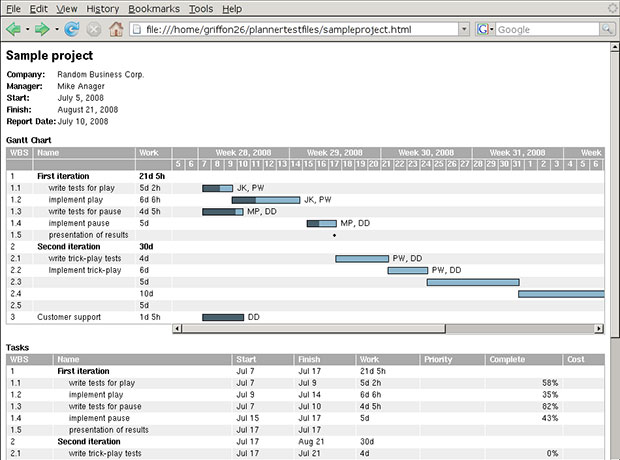
The WBS approach provides a common framework for the natural development of the project’s overall planning and control. It is the basis for dividing work into definable increments. From that framework, you can create a workflow statement that includes technical, schedule, cost, and labor hour reporting.
This technique defines and organizes the total scope of a project. It lets you compartmentalize subordinate costs for tasks, materials, and such into their successively higher level “parent” tasks, materials, etc. For each element of the work breakdown structure, you generate a description of the task to be performed.
Planner is organized around the primary products of the project (or planned outcomes) instead of the work needed to produce the products (planned actions). It includes two major display components:
- A Gantt chart lets you visualize the project in time segments. You can adjust the time needed for tasks or define dependencies between them with an intuitive drag-and-drop interface.
- Task view shows the complete breakdown of your project along with the estimated cost and effort needed. This helps you spot assignment conflicts so you can rearrange schedules.
Other handy features help you track resource usage. You can print to a PDF file or export to an HTML. Either way, Planner gives you a useful summary in a single file that you can send via email to project participants who can view the report with a PDF viewer or a Web browser rather than an installed copy of the Planner application.
Binary releases are provided by the various Linux distributions. The last new release is version 0.14.6 in December 2011.
GanttProject: Packs Planning Power and Portability
GanttProject, compared to other project management tools for Linux, such as TaskJuggler and Planner, delivers fewer planning features. However, what it does have available may be all that you need if you are not in a large corporate setting.
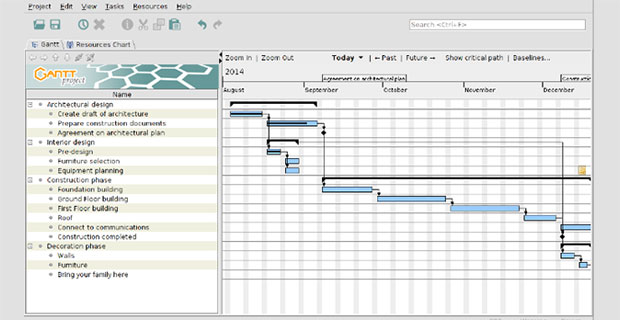
GanttProject’s toolset offers a simplified approach to planning and controlling resources and schedules to meet the objectives of a project. What you get is a variety of task building, project charting and milestone implementation tools. These come at you in a series of bars, graphs and charts.
A GPL open source application, it offers project scheduling as its main function. It is a file-based project management tool that comes with a good starting set of features, including resource management through resource load charts. It supports MS Project files and produces reports in PDF, spreadsheet and HTML formats for easy distribution to team members.
This basic feature set may not be the best solution for seasoned project managers looking for a management product that is not so limiting. Still, GanttProject is the go-to choice for small businesses that do not need high-end extra features found in other project management packages.
GanttProject’s user interface is structured clearly so it is easy to understand. Despite this ease of use, first-time project manager app users will need to familiarize themselves with how Gantt charts and similar tools function.
GanttProject lets you break down a project into a tree of tasks to assign available human resources to work on each task. This makes it easy to establish dependencies between tasks. This approach prevents you from starting one task until an essential prerequisite task is completed.
One of the nicest assets is GanttProject’s portability. You can export some or all of a project’s parameters in .xml format with ease. Also, you can import and export project information to and from MS Project files or text files.
Portability is simplified by the ability to export GanttProject charts as PNG images, or to generate PDF and HTML reports. Similarly, GanttProject can import projects from and export them to Microsoft Project formats. This type of functionality often causes data inaccuracies in some data-heavy programs.
The latest version is 2.8.10, a DEB package for Ubuntu, Mint and other Debian-based Linux distributions. Java Runtime is not included in the package but is listed in the dependencies.
TaskJuggler Makes Balancing Project Tasks More Flexible
TaskJuggler uses a different approach to project management than traditional Gantt charts use. Its goal is to plan and track project details with more flexibility. It covers the complete spectrum of project management tasks and focuses on project scoping, resource assignment, and cost and revenue planning, as well as risk and communication management.
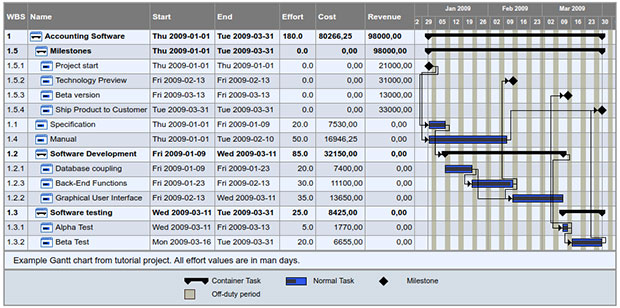
TaskJuggler optimizes scheduling by computing your project timeliness and resource assignments based on the project outline and the constraints you provide. It does this using a built-in resource balancer tool and consistency checker. This helps you eliminate irrelevant details and alerts you if the project gets out of hand.
This flexible approach allows you to plan your project as you go. It makes an ideal solution using new management strategies such as extreme programming and Agile project management.
Written in Ruby, TaskJuggler is easily installable and usable. It does not need a graphical user interface. A command shell, a plain text editor (no word processor!) and a Web browser are all you need for your work.
TaskJuggler’s features include components to manage tasks, resources and accounts of your project. It includes a powerful to-do list management tool and a detailed reference manual. It also has advanced scheduling tools that include automatic resource leveling and task conflict resolution.
The scheduling process lets you use an unlimited number of baseline scenarios of the same project for assessing what-if analysis, flexible working hours, and leave management. It also has support for shift working and multiple time zones.
Accounting issues are a key part of TaskJuggler. It tracks initial costs and finishing costs. It addresses resources through usage-based costs and resource base cost models. It supports profit/loss analysis.
TaskJuggler has scaling and enterprise features that let you combine related smaller projects with larger projects. It includes support for a central resource allocation database and manages roles and complex reporting lines.
TaskJuggler is a bit more modern than some of the other project managers in this roundup. Version 3.6.0 was released on in March 2016.
OpenProj: A Microsoft Project Replacement
If you are familiar with MS Project and want a clone-like alternative for Linux, check out OpenProj. Its user interface is very similar. OpenProj opens existing MS Project files and is interoperable with Gantt Charts and PERT charts.
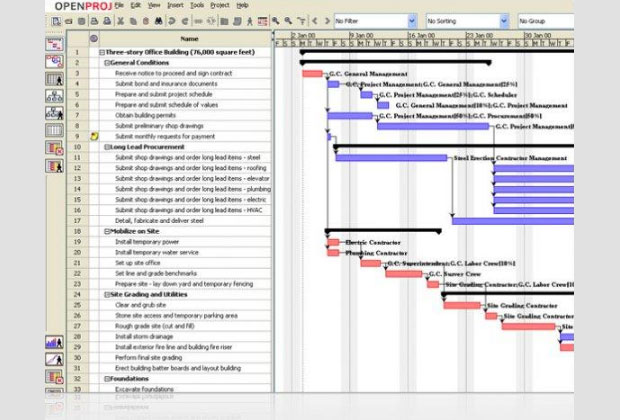
OpenProj comes in three options: Community (free), Cloud and Enterprise. The features are more significant for the latter two options. The community version offers an impressive feature set and in many cases works well for individual and SMB use cases. More professional productivity features are available for users who subscribe to the Cloud and Enterprise Editions.
OpenProj’s design is clean, uncluttered and well organized with an intuitive and easy-to-use graphical user interface. It comes with advanced feature tools. It covers essential business requirements: CRM, HRM and financial management, as well as workflows that can be set up for approval.
Like Planner, OpenProj supports the graphic view of work breakdown structure. Unlike other options in this roundup, OpenProj has no resource leveling function and can not export data to a spreadsheet.
However, OpenProj makes it easy to define the project’s objectives and specify the work details. It is easy to analyze the required activities and create a detailed plan that shows how and when the project will provide the deliverables defined in the project scope.
Other components include time tracking, cost reporting and budgeting. Team members can create the project wiki to help manage project documentation, references, guidelines and user manuals.
This application started out as a Java-based open source project management tool developed in 2007. Serena Software acquired the product in 2008 and stopped its development. Micro Focus in May 2016 acquired Serena. In 2012, the original creators of OpenProj forked the abandoned code and developed ProjectLibre (see below), which initially was released in 2012.
OpenProj Version 1.4 is the latest release, updated on March 10, 2019. It is no longer compatible with MS Project, however. As far as I can tell, it is available only as an RPM package, so it is not universally available for all species of Linux distros.
dotProject: Browser-Based MS Project Alternative
dotProject is a project management solution for small and mid-sized businesses that do not have to focus on extensive financial management issues as a part of tracking project processes. Its biggest advantage is an easy-to-use interface. Other pluses include the ability of multiple users to work collaboratively, which makes issue-tracking easier.

dotProject is a Web-based framework that includes modules for companies, projects, tasks (with Gantt charts), forums, files, calendar, contacts, tickets/helpdesk, multilanguage support, user/module permissions and themes.
It was developed originally as an open source replacement for Microsoft Project. It has a similar user interface plus additional project management functionality. Critics and reviewers regard dotProject as one of the best-maintained open source project management applications available. It has an intuitive browser-based interface and offers a full collection of advanced project management tools for multiple users, as well as time-tracking tools.
Task Management features include Task Description, Task Assigning, Project Scheduling and Task Duration. The application has nodal user permissions, discussion dashboards, Gantt charts, contact lists, file checkout, reporting, and user-based or list-based task features.
dotProject suffers from several potential drawbacks. One is the need for advanced expertise for installation. Another makes it less practical for small businesses and home users: It must run on a Web server and is not a standalone application.
The latest stable edition is version 2.1.8, released in July 2013.
ProjectLibre: Mapping the Critical Path
ProjectLibre is another open source alternative to Microsoft Project. ProjectLibre is compatible with Microsoft Project 2003, 2007 and 2010 files.
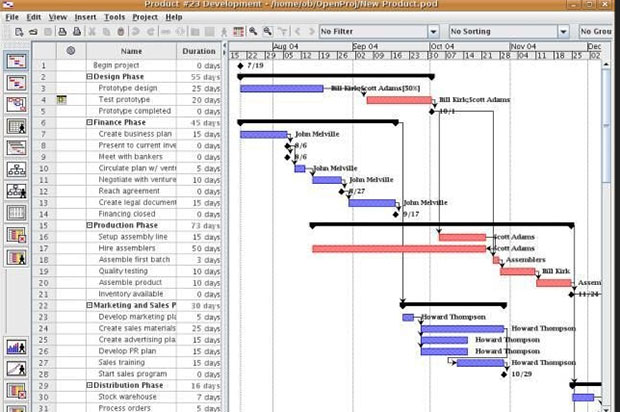
This is a free Web-based open source application. ProjectLibre is an ideal project management application for small to mid-sized businesses that have single project requirements.
An enterprise cloud version coming soon will be offered as a simple monthly subscription. The cloud version is best for teams and for managing multiple projects.
ProjectLibre uses a ribbon interface that allows users familiar with MS Project to transition easily to this alternative. For example, creating a project plan involves the same approach: List and indent a task list or apply a work breakdown structure.
The application supports setting durations, links, predecessors and resources in a similar manner to MS Project. Also supported are creating budgets and managing expenses.
ProjectLibre’s core functionality includes Gantt charts, network diagrams, work breakdown structure charts, resource breakdown structure charts, earned value costing and resource histograms. These are comparable to features in Microsoft Project.
ProjectLibre lets you set dependencies, create a project baseline, and use multiple calendars to define working and nonworking days for different resources. It also has reporting functionality, such as for displaying project details, resource information and task information.
Released under the Common Public Attribution License, ProjectLibre qualifies as free software.
The latest version, 1.8.0, was modified in May 2018.
Bottom Line
Project management applications for Linux offer an overlapping range of features and user interfaces. I deliberately avoided ranking these Linux products. I also suspended the usual star rating for each one in this roundup.
Project Management software for Linux, much like Time-tracking, Task Management and To-Do List software for Linux, is increasingly overshadowed by cloud services. That is one reason open source applications available for the Linux platform lack many new non-cloud contenders.
Most of the open source products in this roundup are available for Windows and Mac computers as well. Even the Web-based open source platforms for product management applications are available for free. With the exception of the Web-based products, they share one characteristic: None of them has a very recent new release.
Want to Suggest a Review?
Is there a Linux software application or distro you’d like to suggest for review? Something you love or would like to get to know?
Pleaseemail your ideas to me, and I’ll consider them for a future Linux Picks and Pans column.
And use the Reader Comments feature below to provide your input!
























































Hey Jack! I am Ashley Marsh and I have read one of your blog posts about open source tools for staying on top of projects and really found it interesting. Not all project management solutions are the same, some agile project management tools are perfect for developers and designers. The type of organizing tools we use to plan our projects can make the work routine more efficient and improves the productivity. The sort of organizing instruments you employ to plan your tasks could make your work routine extra environment friendly and enhance your productiveness. The points that has been discussed by you in the article are very informative and helpful. I have had a great reading this post and will definitely looking forward to reading more such blog posts from your end in future.